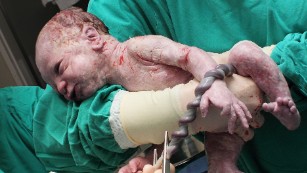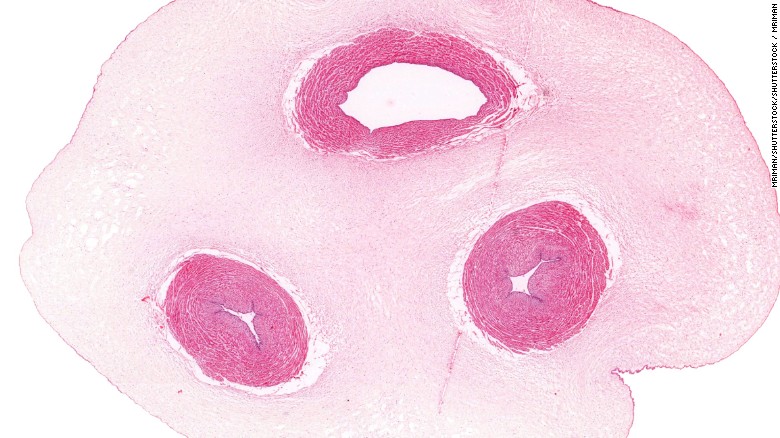What's really going on behind your belly button
 Our belly button is a reminder for life that once we were
attached to and dependent on our mother, floating like a little astronaut in
our liquid universe.
Our belly button is a reminder for life that once we were
attached to and dependent on our mother, floating like a little astronaut in
our liquid universe.
The cord, and in particular the remaining belly button, has
always been fascinating to humans and we still embark on some interesting
traditions to celebrate and aid the physical separation of the umbilical cord.
The umbilical cord is probably the baby's first toy, as they are
sometimes caught on ultrasound playing around with it.
Cutting the cord at birth is one of the most common surgical
procedures in the word today and at some point almost every human on earth has
undergone this.
 Recent scientific evidence has made us
rethink how soon this should occur after birth, with evidence the baby can
receive as much as another 80-100ml (almost a third of its total blood volume)
if we just delay clamping and cutting the cord for three or more minutes after
the birth.
Recent scientific evidence has made us
rethink how soon this should occur after birth, with evidence the baby can
receive as much as another 80-100ml (almost a third of its total blood volume)
if we just delay clamping and cutting the cord for three or more minutes after
the birth.
Not only do babies get more blood this way but this extra blood
volume has a positive impact on child development.
The umbilical cord forms very
early on in pregnancy and basically gets longer due to the increasing baby
movements until it reaches around 50-70cm. And babies who move a lot tend to
have longer cords.
The umbilical cord is made up of
one large vein and two smaller arteries. The vein carries the oxygen-filled
blood from the mother to the baby. The arteries carry the oxygen-depleted blood
and waste products from the baby back to the mother. The cord inserts into the
placenta so it's not directly connected to the mother's circulation.


The placenta acts like a very
sophisticated filtering system. In order to protect the blood vessels from
compression while the baby moves about, or when it is being born, the cord is
filled with a jellylike substance called Wharton's jelly. Think of it as
nature's airbags. This is why most of the time when the cord is around a baby's
neck at birth (a common event) it's not a problem.
At some point after the birth
the cord ceases its important function of taking blood back and forth between
the mother and baby. Once cut and clamped it withers away into a firm black
stump over the first week of life before falling off and leaving that much
adored belly button.
People joke about belly button
fluff and some decorate this part of their body with piercings and jewels. But
is more going on beneath this shriveled reminder of our beginning on this
earth?
After the baby is born and takes
that first breath, blood is shunted to the lungs, which have been reasonably
quiet up to that point as they have been filled with fluid. An amazing switch
happens in the circulation with the two arteries constricting to stop the flow
of blood to the placenta and then the vein slowly collapsing.
Internally the veins and
arteries in the cord close up and form ligaments, which are tough connective
tissues. These ligaments divide up the liver into sections and remain attached
to the inside of the belly button.
The part of the umbilical
arteries closest to the belly button degenerates into ligaments that serve no
real purpose but the more internal part becomes part of the circulatory system
and is found in the pelvis supplying blood to parts of the bladder, ureters and
ductus deferens (a tube sperm moves through in males).
Rarely a canal remains that
connects the bladder to the belly button. This leads to urine leaking out of
the belly button and this is an abnormality that would need to be surgically
repaired following birth.
Ever noticed that when you stick
a finger in your belly button you can feel tingling around your bladder and
pelvic area? Now you know why. What was once a highway of blood from mother to
baby turns into ligaments and some continued connection to blood supply deep
inside your body.
So next time someone tells you
not to navel gaze you will have a smart come back about just how amazing the
navel really is.
Hannah Dahlen is a
professor of midwifery at Western Sydney University.
Copyright 2017 The
Conversation. Some rights reserved.


![Connected Development [CODE] - Launching of Its Election Monitoring Tool “UZABE”](https://blogger.googleusercontent.com/img/a/AVvXsEhuvfrIxiltRPh4TrIipS6JP1LEa2y8oIrwLLGAoRyBN6Vr9zViZ1LuQ-Ks0VOwmfB1S15ql0bZAUaTLUT2UTc2a2oqxiMPd2msZmRD3X3Ie0YKJOnaW5Q3idcik82mt3PVvr2uroWhj-uwv-Al-IUdehkL0icJw5iH_b16Zwpv0aX2RdUwjKcKYTbYCA=s72-c)







Post a Comment